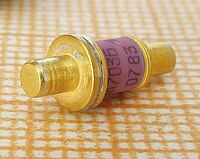
Photo from wikipedia
Abstract Bidirectional multiple negative differential resistance (BM-NDR) was observed from a single 2,3-Dichloro-5,6-dicyano-1,4-benzoquinone (DDQ) molecule at room temperature when the device was studied by using density functional theory (DFT) in… Click to show full abstract
Abstract Bidirectional multiple negative differential resistance (BM-NDR) was observed from a single 2,3-Dichloro-5,6-dicyano-1,4-benzoquinone (DDQ) molecule at room temperature when the device was studied by using density functional theory (DFT) in association with non-equilibrium Green's function (NEGF). The BM-NDR effect was also verified experimentally by studying the scanning tunneling spectra (STS) of single DDQ molecule. The carrier transport in the device occurs mainly through the transmission channel corresponding to the highest occupied molecular orbital (HOMO) of the molecule and a commensurate change in the magnitude of transmission peak was observed at the peak and valley voltages. The reason for the NDR is proposed to be due to the two competing factors involved namely, the reduction of the molecule and the interface resistance between the molecule and the electrodes. The involvement of both the factors is validated from the molecular projected self-consistent Hamiltonian (MPSH) and the local device density of states (LDDOS) of the device at the corresponding peak and valley voltages.
Journal Title: Organic Electronics
Year Published: 2019
Link to full text (if available)
Share on Social Media: Sign Up to like & get
recommendations!